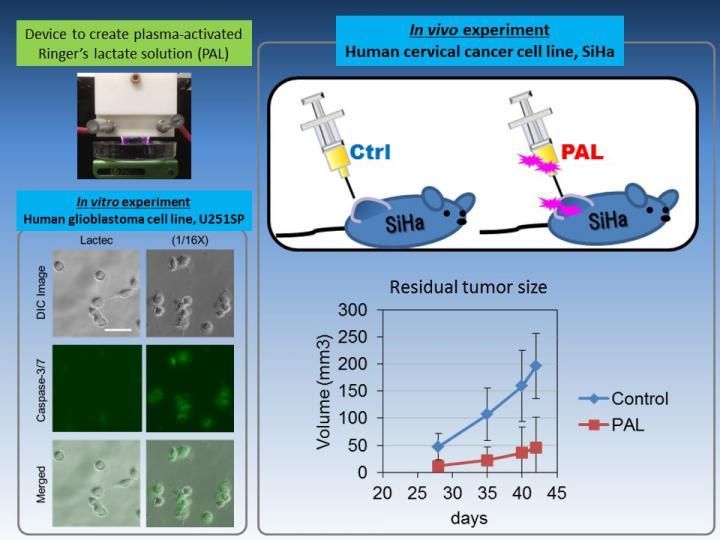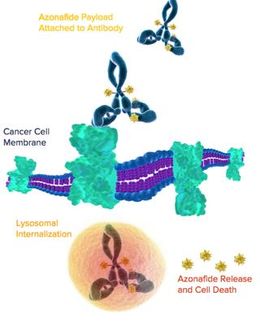Anti-tumor effect of novel plasma medicine caused by lactate
Physical plasma is one of the four fundamental states of matter, together with solid, liquid, and gas, and can be completely or partially ionized (thermal/hot or non-thermal/cold plasma, respectively). Non-thermal plasma has many industrial applications, but plasma medicine is a new field of therapy based on non-thermal atmospheric pressure plasma that has been used in cancer treatment, wound healing, and blood coagulation. Plasma is known to react with air to produce highly reactive free radicals, and with liquid to produce long-lived reactive molecules that can be used for chemotherapy. However, the exact components responsible for the anti-tumor effects were unknown.

We created plasma-activated Ringer's lactate solution (PAL) and investigated its anti-tumor effects on cancer cells. We detected an apoptotic marker, cleaved Caspase3/7 in PAL-treated glioblastoma cells, suggesting that PAL induced apoptosis. We created a mouse xenograft model in which SiHa cervical cancer cells were injected into mice subcutaneously, and the resultant tumors were treated with PAL three times a week for six weeks. PAL effectively reduced tumor volumes.
Nagoya University
Now, a research team based at Nagoya University used plasma to activate Ringer's solution, a salt solution with existing therapeutic functions, and showed that its lactate component had anti-tumor effects.
Previous work by the researchers developed plasma-activated cell culture medium as a form of chemotherapy, but selected Ringer's solution in the present work because of its simpler composition and likelihood of forming less complex reaction products. Ringer's lactate solution (Lactec) was irradiated with plasma for 3-5 minutes, after which it demonstrated anti-tumor effects on brain tumor cells.
Other plasma-activated solutions have previously been shown to induce reactive oxygen species within cells, but these were not detected in plasma-activated Lactec (PAL)-treated cells, suggesting an alternative mechanism triggered cell death. Analysis of PAL identified high levels of hydrogen peroxide, which is a known anti-tumor factor and the probable cause of cell death.
Lactec contains lactate and the salts sodium chloride, calcium chloride, and potassium chloride, in addition to water, so the team systematically analyzed plasma-activated synthetic versions of each component to identify which was responsible for killing cancer cells. "Only lactate demonstrated anti-tumor properties and generated hydrogen peroxide following plasma irradiation," first author Hiromasa Tanaka says. "This indicates that activated lactate increases intracellular hydrogen peroxide levels which cause apoptosis of the tumor cells."
Some cell types were not killed by treatment with PAL, suggesting it could be used as a specific tumor therapy. "PAL also appears to be safe for use in vivo," corresponding author Kae Nakamura says, "as we observed no adverse effects when PAL successfully reduced the tumor volume of mice."
Original publication
Most read news
Original publication
Hiromasa Tanaka, Kae Nakamura, Masaaki Mizuno, Kenji Ishikawa, Keigo Takeda, Hiroaki Kajiyama, Fumi Utsumi, Fumitaka Kikkawa & Masaru Hori; "Non-thermal atmospheric pressure plasma activates lactate in Ringer’s solution for anti-tumor effects"; Scientific Reports; 2016
Topics
Organizations
Other news from the department science

Get the life science industry in your inbox
By submitting this form you agree that LUMITOS AG will send you the newsletter(s) selected above by email. Your data will not be passed on to third parties. Your data will be stored and processed in accordance with our data protection regulations. LUMITOS may contact you by email for the purpose of advertising or market and opinion surveys. You can revoke your consent at any time without giving reasons to LUMITOS AG, Ernst-Augustin-Str. 2, 12489 Berlin, Germany or by e-mail at revoke@lumitos.com with effect for the future. In addition, each email contains a link to unsubscribe from the corresponding newsletter.


















































